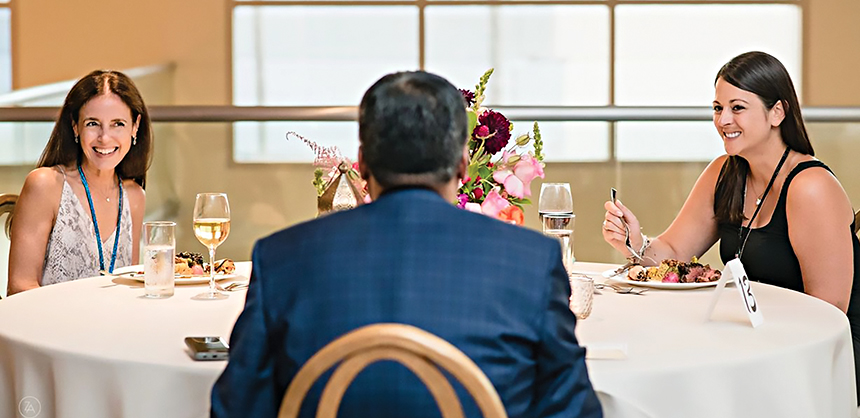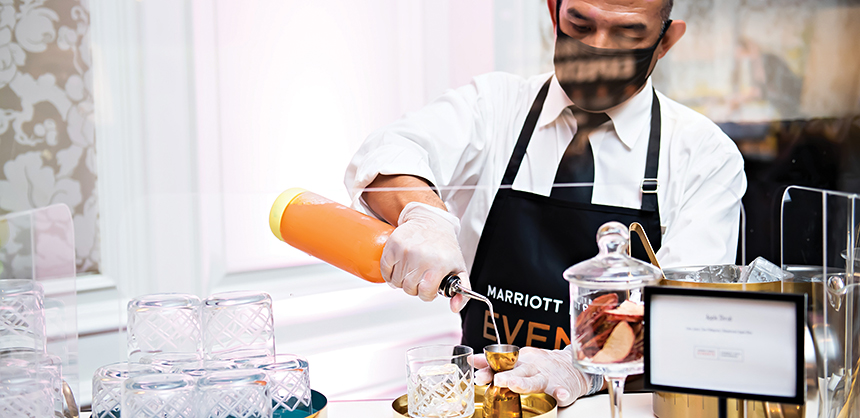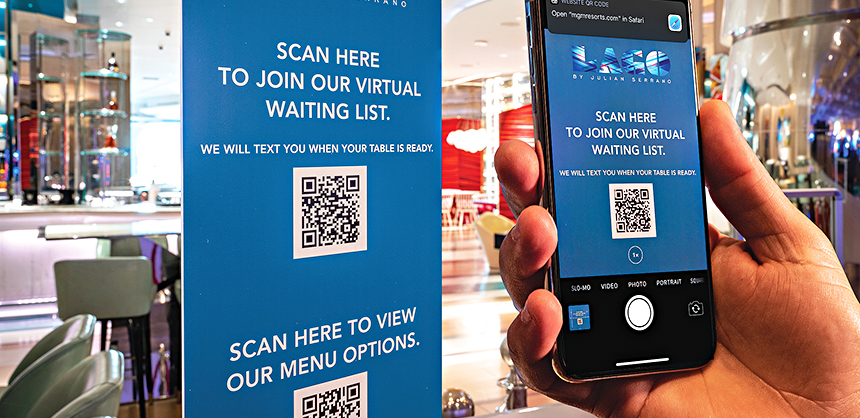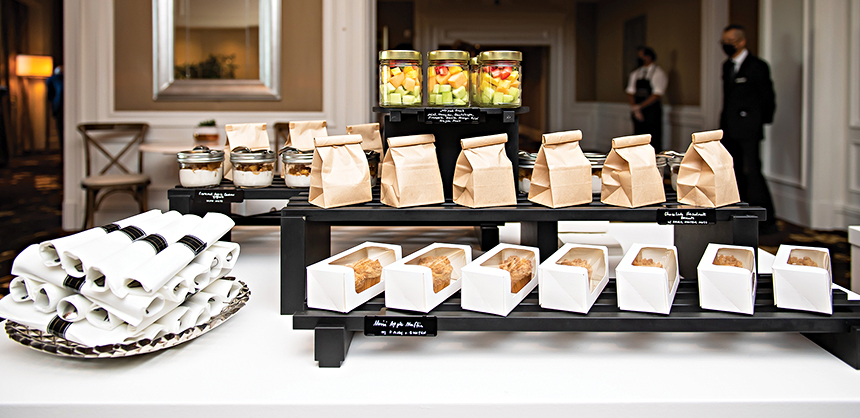Certain F&B Trends Are Here to Stay Post PandemicApril 1, 2021
By Maura KellerCertain F&B Trends Are Here to Stay Post Pandemic

Planners say attendees are now looking for experiences when it comes to F&B, so merely serving a meal buffet-style is no longer good enough. Photo Courtesy of Katie Bohrer / ALHI
For years, the standard food and beverage offerings at meetings and events were simply that — standard. Today, despite COVID-19’s temporary impact on how food and beverages are served, food and drink options are wide ranging to meet the evolving dietary interests of attendees.
Bryan Stiffler, director, meetings and special events at The Ritz-Carlton, Tysons Corner in McLean, Virginia, says, from his experience working in special events and meetings over the years, he’s seen a rise in demand for plant-based foods. “While there has historically been a focus on responsibly sourced local ingredients, during the pandemic, I’ve seen an increased number of requests for comfort foods,” Stiffler says. “With everything going on in the world, I think these comfort foods have made a comeback as people have been craving some normalcy and will take any opportunity to find joy in their day.”
The key to elevating the food and beverage experience at these meetings and events, despite the potential challenges, is to begin planning your food service as soon as possible, as advanced planning affords the greatest creativity. Deanna Nwuso, founder and event strategist at Deanna Camille Events, says COVID-19 has obviously had a major impact on in-person meetings and events. Pre-pandemic, the focus was on local cuisine and ingredients, served farm-to-table when possible. “Attendees are seeking experiences that spill over into the food at an event,” Nwuso says. “So food displays that are jaw-dropping or service styles that are Instagram-worthy are what attendees are looking for.”
The food and beverage industry is increasingly focusing on satisfying the adventurous consumer. In fact, meeting and event attendees are moving out of their comfort zones to explore bolder flavors and multi-sensory food experiences. There is a focus on heightened sensory delivery, often combined with an element of the unexpected. According to Doug Peterson, partner and founding member at Prestige Global Meeting Source, in recent years, the use of action stations for group food and beverage was a major trend. Action stations allow for variety, creativity, fresh preparation and “theme-able” or customizable experiences. “The integration of healthier options has been a growing trend with the addition of new food options as tastes and trends changed over time,” Peterson says. Communal dining was becoming the norm pre-COVID. Family style service for groups had also been growing pre-COVID, creating a more relaxed and engaging group dining environment.
As food trends move into more esoteric realms, the crowd pleasers still largely remain comfort foods. An example would be lobster macaroni & cheese with truffles, or other fun or indulgent variations, highlighting that the tried-and-true favorites are still desired. “Ethnic foods have seen a rise in recent years, adding more variation in flavors. Sushi has become a favorite now where 10 years ago that would have been a rarity,” Peterson says. “Fresh squeezed juice bars were big before COVID, as was ‘clean eating’ such as customizable ‘bowls’ with rice or greens as a base, which can appeal to many food preferences. Dishes featuring seasonal ingredients remain popular with the masses.”
According to Heather Herrig, CMP, president and chief event strategist at Every Last Detail Events, planners are more in tune with how to adequately fuel the body and brain with energizing choices. Gone are those afternoon breaks of brownies and cookies, sure to just bring along an epic energy crash shortly thereafter. “Instead, we are seeking options that help our participants focus and engage in the content we’ve worked so hard to co-create,” Herrig says. “Sourcing has also evolved quite significantly in recent years. We are looking at food and beverage more inclusively within the event or meeting as a whole, and want this to be a part of the destination experience. Sourcing locally allows us to share the destination’s story and bring it into the event in a powerful way. Plus, it allows us to support local producers and encourage a more sustainable F&B program overall.”

The Ritz-Carlton, Tysons Corner – Connect with Confidence Event. (Joy Asico / Asico Photo)
Beyond Thirst Quenchers
The idea of “craft everything” seems to be the way of today’s beverage, including local, regional, and craft made beers and wines. The popularity of small batch, non-consumer brand or in-house produced drinks has also risen. “Wine has always been and remains a standard, but beer and distilled spirits have become much more prominent,” Peterson says. Hotels are seeing an increase in demand for whiskey-, rum- and cognac-tasting and pairing for workshop, team building, educational purposes, etc. Peterson adds, “We have also seen a resurgence of some tried-and-true drinks with a modern spin, such as a wood smoked Old Fashioned or a Vesper Martini.”
In addition, fruit-infused water, available all-day for attendees, was becoming very popular pre-pandemic. But because service for that was primarily in large format, self-serve dispensers, that is not the option it was a year ago. Still, Herrig says planners can get creative when providing this enhancement to hydration. Sponsors can provide water bottles that allow for fruit infusion, and both fruit — in single servings — and water can be safely made available to attendees in person. “If you have a virtual event, the same water bottles can be sent in advance with recipes of different fruit combinations,” Herrig says. “There are really some fantastic non-alcoholic options now, too. We are seeing craft non-alcoholic spirits gain in popularity as well, so there are fantastic options for everyone.”
Experiential beverage service also is very popular in today’s meetings and events. As Nwuso explains, not only do attendees want to be served creative, one-of-a-kind drinks, they want to be entertained in the process as well. “At an event a few years ago, I coordinated a coffee-tasting experience with a local roasting company at an event in Seattle. Attendees watched him pour over a cup as well as explain what to look for in quality coffee and the best way to brew at home,” Nwuso says. “And they all received an espresso set to take home to remind them of the event in the future. By creating something engaging like this, your attendees look forward to attending in the future, they tell other potential attendees about it and create a ‘fear of missing out’ for the next year.”
Throughout the pandemic, Stiffler has noticed an increased demand for fermented experiences, such as kombucha, and immunity-boosting beverages such as fresh-pressed juices and smoothies to keep their immune systems strong has become top-of-mind for clients. “I’ve also seen a rise in the number of requests for stations with attendants or an experience where the server comes to the guest with, for example, a coffee trolley or cart,” Stiffler says. “What’s more, there has been more demand for non-alcoholic alternatives like elixirs with shrubs and sparkling water, as well as single-use, individually bottled beverages.”
Accommodating Needs
As gluten-free, dairy-free, Keto and other types of dietary restrictions become more prominent, meeting professionals have to plan accordingly. As Peterson explains, the early attempts to provide options were clearly a “check-the-box” type offering, however, for many hospitality kitchens and bars these days, the conversation begins with the question of what food sensitivities or allergies exist within the audience of which they may need to be made aware. “The scale and scope of more artisanal versions of classic dishes made with these modern modifications or exclusions makes it difficult when the request only represents a small minority of guests,” Peterson says. “Vendors that can find ways to create ‘wow’ experiences with the limited-diet crowd will really stand out.”
Peterson suggests that these menu modifications will only continue to grow as the trend overall is moving toward more health-conscious eating. While many do a great job with unique dietary requests and requirements, there are still vendors that just simply label what ingredients are in the food, so people may make informed choices. “A tactical approach is to think about the eaters and make sure each group can find things that will meet their needs and find a couple of surprises in the offering,” Peterson says. “Catering to specialty needs is now the norm, not the exception. Banquet menus created solely with this in mind is a must. Some hotels are designing full menus that are all vegan, for example, and we are seeing more and more clients looking for those menus.”

MGM Resorts International has introduced technology where attendees can scan QR codes with their mobile device and view event menu details. Photo Courtesy of Victoria Chivers
Of course, as an event planner, it is impossible to create one menu that addresses the full spectrum of dietary needs and requests. Nwuso has tried to make sure that during each meal there are food items that meet a variety of needs. For example, serving salads without nuts or cheese, dairy-free starch sides, such as potato croquettes, or build-your-own taco stations that include lettuce wraps in addition to traditional flour and corn tortillas, have all worked well. “Secondly, it is now widely expected to label all food with dietary concerns or allergens so attendees are fully informed as to what they’re being served,” Nwuso says. “Sometimes, you may have to just order special food for attendees, like for those who eat Kosher, and make sure you have a method of locating and serving those attendees during meal functions.”
Herrig says the key is to learn how to listen and then how to plan, so a vegan meal isn’t just a plate of vegetables, but something as appetizing and delicious as any other entrée. “Dietary restrictions and dietary lifestyles are impacting our industry because they are pushing us in very constructive ways to plan better,” Herrig says. “We need to be more creative and more collaborative to successfully feed all our guests and participants safely and with care. These needs are pushing us to be better planners and better industry partners.”
And while there are definitely many more requests to accommodate allergies, and dietary preferences or restrictions, than ever before, those who eat bread, love bread, so that won’t be going away anytime soon. “But the need to have a low-carb, non-starch, non-gluten base as a vessel for the protein or whatever else is being served is the quest. You’ve seen cauliflower ‘dough’ for pizza,” says Shaun Roberts, vice president of sales for Great Performances catering and events company based in New York City. “Generally, though, I think we are steering toward more plant-based meals, and that is something easily achieved, and can accommodate most allergies. There is so much great flavor organically occurring in nature, and we will see more and more creativity in that direction to keep our taste buds engaged.”
Victoria Chivers, vice president of catering, MGM Resorts International, says dietary requirements and preferences have played a large role in events and the overall curation of catering menus for many years, and MGM Resorts continues to develop new ways to streamline this for planners and attendees. “For example, we are excited to introduce new technology where every event guest will have the ability to scan QR codes with their mobile device and view event menu details,” Chivers says. “Additionally, our culinary concierge is also available at several of our properties by simply texting any questions about the menu and [receiving] quick responses back from the chef.”

At The Ritz-Carlton, Tysons Corner, chefs introduced bento-style and/or market-style meal presentations in their meetings and events. Photo by Joy Asico
Delivery With a Purpose
And due to the pandemic, how food and beverages are served is as important as what’s served. For example, at The Ritz-Carlton, Tysons Corner, they’ve introduced bento-style and/or market-style presentations in their meetings and events. “During the stay-at-home orders, executive chef Frederic Barasse and I brainstormed on how to best serve a function,” Stiffler says. “In response, we created bento-style breakfast, lunch and dinners, which are served on beautiful acrylic trays. For the events that want a more traditional buffet experience due to the array of options, we created market-style buffets with food stations where each item is individual wrapped in a biodegradable container.” At these food stations, they have proper guards in place, allowing for an experience where the attendees’ and attendants’ well-being are top of mind.
The Ritz Carlton, Tysons Corner recently served an event lunch in stackable ceramic containers. The container had three components — the top was for salad, the middle was the warm entrée and the bottom was dessert. These containers only required the server to visit the table once, thus limiting contact between the server and guest. “At the end of the day, every event has a different comfort level with COVID, and it’s so important, now more than ever, to find ways to cater to these individual needs,” Stiffler says.
As we continue to navigate meetings during this time, Chivers is seeing many groups opting for plated events that limit interactions with staff and other attendees. “We’ve created inventive ways to revitalize this experience with a ‘one-drop service’ that features a bento box-style meal perfect for lunches with time constraints,” Chivers says. “For groups still looking to offer a wide variety of selections, we’ve created marketplace pods to take the place of traditional buffets, where guests are served by attendants and chefs with packaged portions presented in beautiful, creative arrangements.”
“I firmly, and happily, believe long buffet lines will be a thing of the past.” — Doug Peterson, Partner and Founding Member, Prestige Global Meeting Source
Joel Feigenheimer, assistant professor at the Florida International University’s Chaplin School of Hospitality & Tourism Management, points out that hotel operators, caterers and restaurateurs are always trying to present their food and beverage products in unique and interesting ways. The issue with food and beverage presentation during meetings and events is more related to the logistics of delivering the food to all attendees in a reasonable amount of time versus designing plates or beverages that are beautiful and unique but are hard to produce and distribute. “Meeting food must not only be of commensurate quality with the budget, but the operator must be able to feed the attendees in such a manner that it does not interrupt the flow or timing of the meeting or convention schedule,” Feigenheimer says. “Companies don’t care how pretty the food is at lunch if the convention runs 45 minutes late because the operator was unable to feed everyone on time.”
-
Looking Ahead
Peterson anticipates we’ll take the best of what we’ve learned for cleanliness and efficiency and these will become new standards. To some extent, the former ways of food and beverage service will come back with some modifications. A family-style meal still brings a camaraderie to a table and will find its way back. Peterson would like to think instead of a “new normal” we will see an “improved normal,” taking the lessons learned forward from this challenging time. “We are rethinking everything from the moment the delegate walks in the door to the moment they leave the event,” Peterson says. “Reinventing ways of doing the basics in terms of seating, service and even the creation of banquet event orders. I firmly, and happily, believe long buffet lines will be a thing of the past.”
Chivers adds that with challenge comes innovation — and the pandemic has given the industry time to evolve new catering options and introduce new technology to enhance the guest experience. “In looking at everything through the lens of health and safety,” Chivers says. “We’ve also developed new service and presentation alternatives that allow meeting planners to truly customize an event that is enjoyable and comfortable for all.” C&IT








